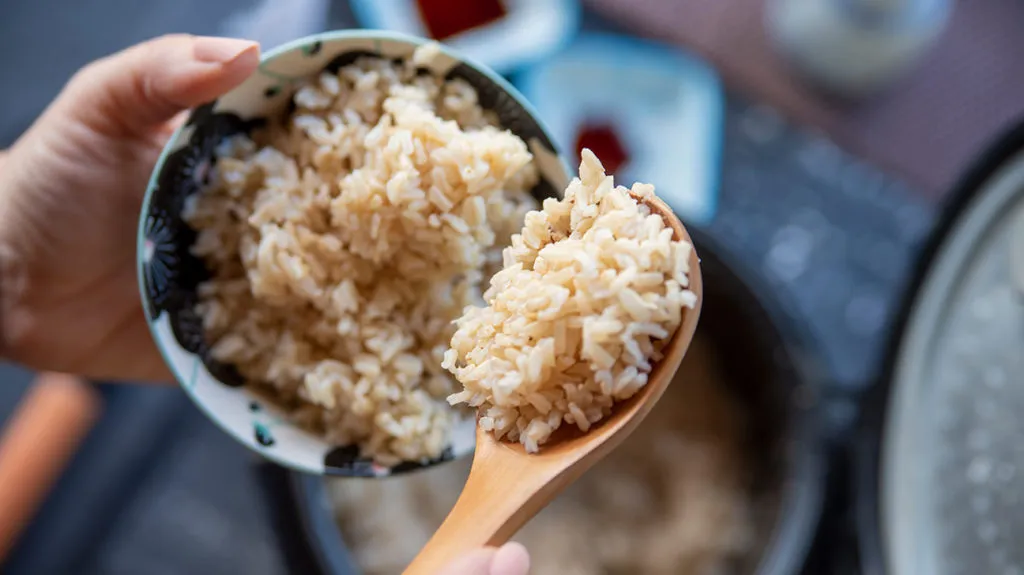Rice (Oryza sativa) contains carbohydrates, which give energy, but can raise blood sugar. Brown rice has more fiber, which helps support gut health and reduce inflammation.
Rice is one of the oldest cereal grains in the world, and people have grown it for at least 5,000 years. It is a staple food for more than half (Trusted Source) of the world’s population, and 90% of the world’s rice comes from Asia.
There are thousands of types of rice, but depending on how producers process them, they fit into two groups: white or brown (whole grain).
White rice is the most common type, though brown rice offers more health benefits. Brown rice comes in a variety of shades, including reddish, purplish, or black.
Manufacturers make many products from rice, including rice flour, rice syrup, rice bran oil, and rice milk.
This article looks at the nutrition, health benefits, and risks of white and brown rice.
Nutrition
Both white and brown rice contain mainly carbohydrate and some protein, with virtually no fat or sugar.
Cooked rice contains a lot of water, making up almost 70% of its total weight.
White and brown rice have similar calorie, carbohydrate, protein, and fat content. A 100 gram (g) serving of white, short-grain, cooked rice contains the following nutrients:
| Nutrient | Amount | % Daily Value (DV) |
| Calories | 130 | |
| Carbohydrate | 28.7 grams (g) | 10% |
| Protein | 2.36 g | 5% |
| Fat | 0.19 g | 0% |
Carbohydrate
Rice is primarily composed of carbohydrate, which makes up almost 80% of its total dry weight.
Most of the carbohydrate in rice is starch. Starch is the most common form of carbohydrate in foods.
Starch is made up of long chains of glucose called amylose and amylopectin. Different types of rice have varying amounts of these compounds, which affects the texture of the rice:
- Basmati rice is rich in amylose, meaning it does not stick together after cooking.
- Sticky rice, or glutinous rice, is low in amylose and high in amylopectin, making it sticky after cooking. This makes it ideal for risottos, rice pudding, and eating with chopsticks.
These compounds also affect how easily the body can digest the rice.
The body takes longer (Trusted Source) to digest high-amylose rice because the amylose slows down starch digestion. In contrast, the body digests sticky rice very easily.
While many people find sticky rice more palatable, quick digestion can lead to unhealthful spikes in blood sugar levels, especially in people with diabetes.
Fiber
Brown rice contains a higher amount of dietary fiber than white rice — 1.6 g per 100 g. During the processing of white rice, the grain loses the bran, or seed coat, which contains most of the fiber.
The bran contains mainly insoluble fibers, such as hemicellulose, and virtually no soluble fiber.
White and brown rice contain varying amounts of a soluble fiber called resistant starch.
Resistant starch increases butyrate in the gut. Butyrate boosts gut health by reducing inflammation, improving gut barrier function, and reducing the risk of colon cancer.
White vs. brown rice
White rice is refined, polished, and stripped of its bran and germ. This increases its cooking quality, shelf life, and tastiness, but significantly reduces its nutritional value. That said, manufacturers usually enrich white rice or replace some vitamins after processing.
Brown rice is an intact whole grain, containing both the bran and the germ, which are the most nutritious parts of the grain. They contain fiber, vitamins, minerals, and antioxidants.
For this reason, brown rice may contain more fiber and nutrients than white rice. Be sure to compare labels when shopping.
Brown rice is better for people with diabetes. White rice can raise blood sugar, while brown rice has a lower glycemic index and can help with blood sugar control.
Read more about white vs. brown rice here.
Health benefits of brown rice
Aside from providing energy and basic nutrients, refined white rice does not offer any health benefits. Enriched white rice does contain added B vitamins that are important for health.
On the other hand, regular consumption of brown, or whole grain, rice can have health benefits. Be sure to compare labels when shopping.
Heart health
Brown rice is a whole grain. Whole grains have a wide range of health benefits.
According to the American Heart Association (Trusted Source), whole grains improve blood cholesterol levels and reduce the risk of heart disease, stroke, type 2 diabetes, and obesity.
Brown rice contains several heart healthy components, such as minerals, antioxidants, lignans, and dietary fiber.
Eating high fiber rice as a substitute for white rice may aid weight loss, along with a decrease in cholesterol.
Healthful plant compounds
Brown rice contains several other plant compounds that research has linked with health benefits.
White rice is a poor source of antioxidants and other plant compounds. Pigmented rice, including red-grained varieties such as purple rice, is particularly rich in antioxidants.
The bran of brown rice may be a good source of lignans and ferulic acid:
- Lignans are antioxidants that research (Trusted Source) has linked with lower risks of heart disease, menopausal symptoms, osteoporosis, and breast cancer.
- Ferulic acid is a potent antioxidant found in rice bran. Review studies say it has anti-inflammatory and antimicrobial effects and may help prevent cancer and diabetes.
Vitamins and minerals
The nutrient value of rice depends on the variety and cooking method. The bran and germ contain a high concentration of vitamins and minerals. White rice does not contain bran or germ and lacks these essential dietary nutrients.
Enrichment may add back some vitamins to white rice. Be sure to read labels when shopping, as different brands may add different vitamins.
The following table looks at the amounts of different nutrients in 100 g of brown rice, white rice, and enriched white rice for comparison:
| Brown rice | White rice | Enriched white rice | |
| Manganese | 42% DV | 16% DV | 16% DV |
| Niacin | 16% DV | 3% DV | 9% DV |
| Thiamin | 15% DV | 2% DV | 14% DV |
| Selenium | 11% DV | – | 14% DV |
| Magnesium | 9% DV | 2% DV | 2% DV |
- Manganese: Many foods, especially whole grains, contain this trace mineral. It is essential for metabolism, growth, development, and the body’s antioxidant system.
- Niacin: Also known as vitamin B-3, niacin in rice is mostly in the form of nicotinic acid. Soaking rice in water before cooking may increase its absorption.
- Thiamin: Also known as vitamin B-1, thiamin is essential for metabolism and the function of the heart, muscles, and nervous system.
- Selenium: A mineral with various vital functions for the DNA, oxidative damage, and hormones.
- Magnesium: This mineral is essential for blood pressure, protein synthesis, energy, and more.
Rice also contains some pantothenic acid, phosphorus, riboflavin, and vitamin B-6, copper, and folate.
Risks
Rice is a safe food staple. Regularly eating rice may, however, have risks, especially if it accounts for a large proportion of a person’s daily food intake.
Type 2 diabetes
Type 2 diabetes is a common condition characterized by high blood sugar levels.
According to a 2019 review, white rice may increase the risk of type 2 diabetes. This is because it has a high glycemic index score, meaning that it can cause large spikes in blood sugar after a meal. Foods with a high glycemic index may increase the risk of diabetes.
That said, the review concludes that the differences between brown and white rice are inconclusive, and further studies in dietary patterns characterized by rice are needed.
On the other hand, brown rice — like other whole grains that contain fiber — may help reduce the risk of type 2 diabetes.
This difference between white and brown rice may be due to variations in the types and amounts of fibers and their glycemic index scores. It is important to note that consuming too many carbohydrates from any source can raise blood glucose levels, so it is important to control portion size regardless of whether the rice is whole grain or refined.
Eating fiber-rich whole grains instead of refined grains may have significant health benefits, including a reduced risk of diabetes.
Read more about rice and diabetes here.
Heavy metals
Heavy metals can accumulate in the body over time, leading to adverse health effects. These include cadmium, chromium, lead, nickel, and arsenic.
Many studies have reported excessive amounts of heavy metals in rice from several countries. This a particular concern where rice makes up a significant portion of a person’s diet.
The bran contains a high concentration of heavy metals, which is why brown rice contains more heavy metals than white rice.
Compared to other common food crops grown in polluted areas, rice accumulates higher amounts of mercury and arsenic.
All cereal grains easily take up arsenic, but it seems to collect more (Trusted Source) in rice compared with wheat and barley.
If possible, people should avoid eating rice grown near heavily polluted industrial or mining areas. This also applies to other food crops, such as vegetables.
Antinutrients
Brown rice also contains an antioxidant called phytic acid, or phytate. This is known as an antinutrient because it prevents the body from absorbing essential minerals, such as iron and zinc.
Producers can reduce (Trusted Source) phytic acid levels by soaking and sprouting the seeds and fermenting the rice before cooking.
Summary
Rice is a staple food across the world. White rice is the most common, but brown rice may have more health benefits.
As a good source of several healthy minerals and antioxidants, brown rice may help prevent heart disease.
On the other hand, white rice — especially sticky rice — provides fewer nutrients and may raise the risk of type 2 diabetes.
Be sure to read the nutrition facts panel and compare the nutrient content and purchase enriched versions of rice when available.



